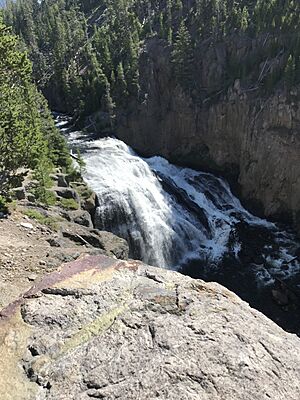Gibbon Falls facts for kids
Quick facts for kids Gibbon Falls |
|
|---|---|
 |
|
| Lua error in Module:Infobox_mapframe at line 185: attempt to index field 'wikibase' (a nil value). | |
| Location | Yellowstone National Park, WY, US |
| Coordinates | 44°39′14″N 110°46′16″W / 44.653825°N 110.77114°W |
| Type | Cascade |
| Total height | 84 feet (26 m) |
| Number of drops | 1 |
| Watercourse | Gibbon River |
Gibbon Falls is a beautiful waterfall located in the northwestern part of Yellowstone National Park in the United States. The water tumbles down about 84 feet (26 m)! You can easily see these falls from the side of the road. They are found on the Gibbon River, not far from where it meets the Firehole River at a spot called Madison Junction.
Discovering Gibbon Falls
The first time Gibbon Falls was officially written about was in 1872. This happened during a scientific trip led by Ferdinand Vandeveer Hayden. A photographer named William Henry Jackson described the falls.
No one knows exactly how the falls got their name. But by the mid-1880s, people regularly called them Gibbon Falls. This name appeared in many official park documents and travel guides.
In 1883, a writer named Henry J. Winser described the falls in his book about Yellowstone. He said the water looked like a "foamy sheet" falling eighty feet. He thought it was a "charming picture" that stood out against the "grim rocks and dusky pines."
Later, in 1895, Hiram M. Chittenden also wrote about Gibbon Falls. He noted that the road was on the opposite side of the river back then. He called it a "waterfall of very irregular outline, but withal one of much beauty." He also mentioned that the road offered a lovely view of the forest below.
Fish and the Falls
For a long time, there were no fish in the Gibbon River above Gibbon Falls. This was because the falls acted like a natural wall. Fish from other rivers couldn't swim upstream past the falls. The upper Gibbon River was cut off from other water systems.
But things changed in 1890. That's when the first Rainbow trout were brought in and put into the river above the falls. Later, in 1920, Arctic grayling were also added to Grebe Lake, which is at the very start of the Gibbon River.
Today, Gibbon Falls still stops fish from swimming upstream from the Madison River. However, because of these fish introductions, the upper Gibbon River is now a great place for fishing.
Images for kids
-
Color litho, Frank Jay Haynes, 1910







